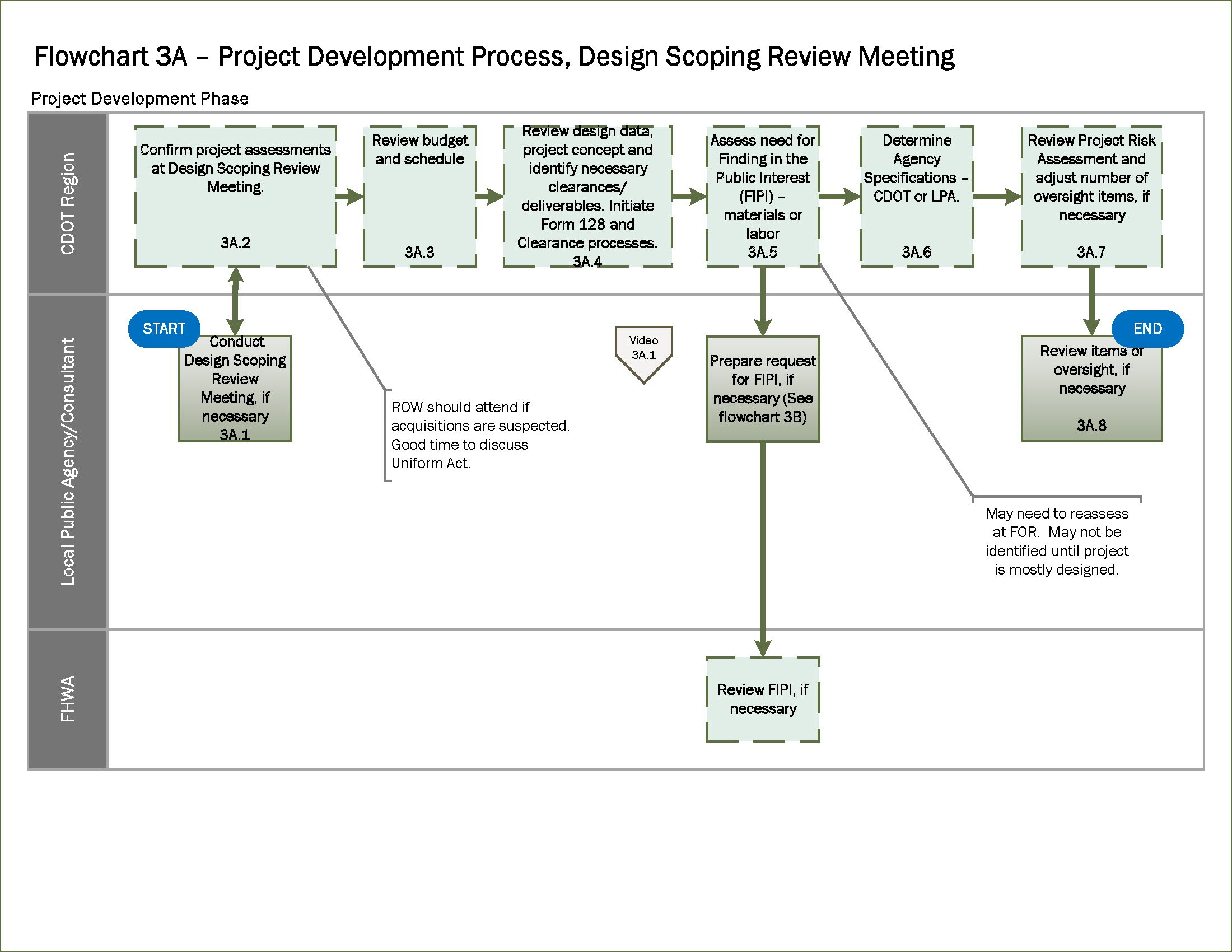Flowchart 3A: Project Development Process, Design Scoping Review Meeting

Download Flowchart 3A (PDF) Download the Flowchart 3A Checklist
Flowchart 3A Project Development Phase Information
- The design scoping review (DSR) creates an early, on-site review of a project prior to preliminary design. This enables development of a scope of work that will be consistent with the planning and design characteristics. For more information, refer to chapter 2.01 of the CDOT Project Development Manual.
- Local Public Agency (LPA) should determine the limits of the project. A draft survey request should be one product of the DSR. For right of way acquisition and plans, survey requirements can be found in the CDOT Survey Manual.
- The project scope must address the CDOT policy for Americans with Disabilities Act Accessibility Guidelines. Refer to CDOT Procedural Directive 605.1, ADA Accessibility Requirements in CDOT Transportation Projects, found under resources on this site.
- Whenever possible, LPA should conduct the DSR after a consultant has been selected, but before executing the consultant contract. This enables all parties to ensure that all task items assigned to the consultant are properly addressed in the consultant contract. The consultant will not receive any compensation for activities that precede the Notice to Proceed.
- CDOT will determine project features and potential issues at the design scoping review meeting, including a review of the project budget and schedule.
- 3A.2 Note: ROW should attend if acquisitions are suspected. Good time to discuss Uniform Act.
- CDOT reviews project budget and schedule
- Following the DSR the CDOT project manager will issue a letter to your agency that identifies items needed to clear the project for construction.
- At the DSR, CDOT will work with LPA to assess the need for a Finding in the Public Interest (FIPI) for force account materials or labor. Under limited circumstances, subject to CDOT's approval, it may be in the public interest for your agency to construct a portion of a project on a force account basis. In this context, the term "force account construction method" means the direct performance of project work by your agency using labor, equipment and materials furnished by it and used under its direct control.
- Information on situations that may justify a request for a Force Account Construction Method – Finding in the Public Interest (FIPI) are listed in CDOT Form 895 Force Account Construction Method – Finding in the Public Interest.
- This assessment will be performed at the final office review meeting, as the need for a FIPI may not be identified until a project is almost complete. If a FIPI is required for a patented, proprietary, research or experimental purpose, refer to Flowchart 3B.
- Additional information can be found in FHWA's video on Cost-Effective Determinations and Public-Interest Findings.
- 3.5 Note: May need to reassess at FOR. May not be identified until project is mostly designed.
- The Standard Specifications for Road and Bridge Construction (referred to as the Standard Specifications) contains the standard specifications used to control the work on federally funded local agency administered projects.
- Standard special provisions revise, clarify or supersede the Standard Specification book to implement current CDOT construction and materials requirements.
- Project special provisions are revisions to the standard specifications that supplement or modify a particular aspect, item or condition contained in the plans, specifications, and bid package specific to a particular project. Project special provisions supersede the standard special provisions and provide the contractor and project manager specific information and requirements related to specific aspects of a particular project.
- Most local agencies use the CDOT Standard Specifications for Road and Bridge Construction as supplemented by CDOT Standard Special Provisions (SSP), and CDOT Project Special Provisions (PSP). Your agency's specifications may be used only with prior approval from CDOT.
- On every locally-administered project CDOT evaluates certain characteristics or features of a project in order to determine the correct level of oversight requirements. This assessment examines the risks associated with procedural non-compliance on a project and provides a framework for addressing risk proactively and continuously. CDOT project manager will review this project risk assessment with you to collectively determine areas of focused oversight.
- Additional information can be found in the Local Agency Bulletin CDOT Use of Risk Assessment in Oversight of Local Agency Projects (Dec. 5, 2014).
- LPA/Consultant reviews items of oversight, if necessary
